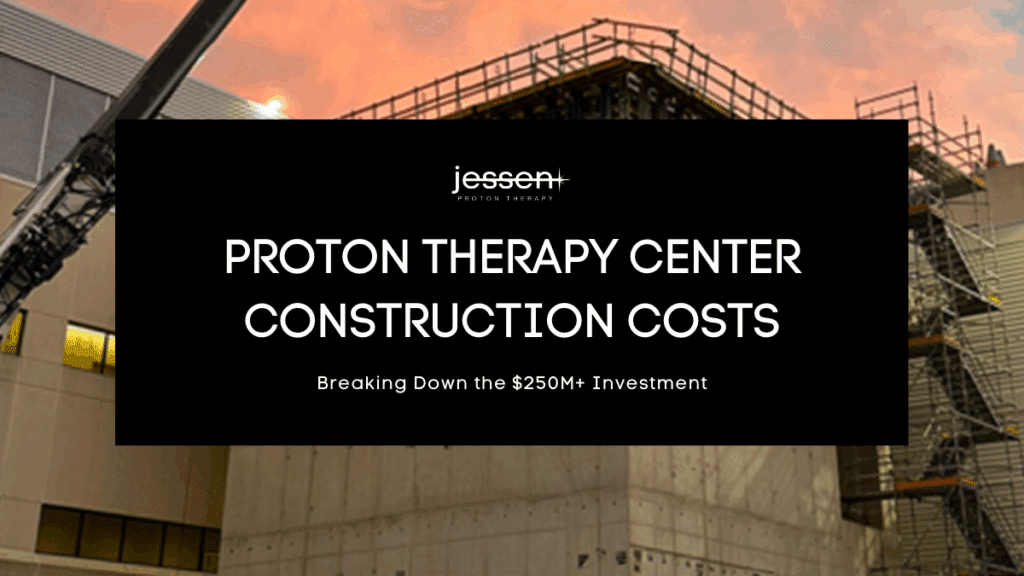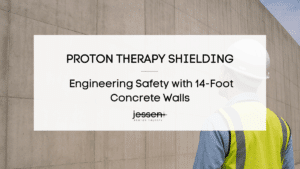Building a proton therapy center is one of the most complex and capital-intensive projects in modern healthcare. Total investments typically exceed $250 million, with costs varying dramatically based on location, equipment selection, and facility specifications. But behind these numbers lies an opportunity to establish your institution as a regional leader in cancer care, attract top-tier oncologists and researchers, and save countless lives.
As architects who have designed more proton therapy centers than any other firm globally, we’ve witnessed firsthand how inadequate cost planning can turn a visionary project into a financial nightmare. Drawing from our work alongside leadership teams at several NCI-designated cancer centers, we’ve outlined proton therapy center construction costs, along with the variables that contribute to them. As with any project of this scale and specificity, total costs are wide-ranging; however, we hope you’re able to use this as a guide to what you might expect as you embark on your project.
With the right planning and expertise, proton therapy centers not only achieve their clinical mission but also become institutional assets. Let’s break down the road to first patient treatment.
Building Construction Costs: Your $50-120M Foundation
The construction costs for proton therapy centers range from $50 million to $120 million, which is just the beginning of the overall project investment. This wide range reflects several critical variables that decision makers must carefully evaluate during the planning phase.
Location, Location, Location: The Primary Cost Driver
As you know, location is everything—and it has a huge impact on construction costs. In Northern California’s more expensive construction market, projects can cost $2,500 per square foot. Compare this to markets like Knoxville, where the same facility might cost $600 per square foot—a four-fold difference that can add tens of millions to total project costs.
Contributing factors to these numbers include local labor costs, material transportation expenses, regulatory requirements, and market competition. US coastal markets with high living costs and stringent building codes inevitably drive up construction expenses, while interior regions often offer more cost-effective building environments.
Equipment Manufacturer Selection
Your choice of a proton equipment manufacturer influences building design and construction costs significantly—a relationship that too many decision makers discover late in the process. Different manufacturers require varying structural specifications, radiation shielding requirements, and mechanical systems integration. Some systems demand deeper concrete foundations, specialized HVAC configurations, or architectural accommodations that can add millions to construction budgets.
Our experience designing the first above-ground proton center demonstrated how equipment selection shapes architectural possibilities. As you’re thinking about your center, evaluate equipment options not solely on clinical capabilities and acquisition costs, but on their construction impact. A seemingly less expensive equipment package might require more costly building modifications, ultimately increasing total project investment. We are deeply familiar with each manufacturer and are always happy to give you our recommendations once we learn more about your project.
Center Size and Room Configuration
The number of treatment rooms directly correlates with building size and complexity. Each treatment room requires substantial concrete shielding, specialized mechanical systems, and sophisticated control infrastructure. Multi-room facilities benefit from economies of scale in shared infrastructure, but each room adds to construction costs.
We designed the industry’s first major proton facility upgrade, which showed us how initial room count decisions ripple through both immediate construction costs and future updates. The architectural framework has to do double duty, meeting today’s clinical demands while preserving pathways for the growth scenarios that make such a substantial infrastructure investment worthwhile.
Equipment Costs: The $200M+ Technology Investment

While building construction is a large expense, the proton therapy equipment itself often exceeds $200 million, matching or surpassing construction. This equipment investment includes the cyclotron or synchrotron particle accelerator, beam transport systems, treatment room gantries, patient positioning systems, and treatment planning computers.
However, the capital equipment costs are only the initial investment. Installation, commissioning, and training add expenses that require careful budgeting. Manufacturers typically require specialized installation teams, extended commissioning timelines, and staff training programs that can add millions to the total equipment investment.
From our experience integrating cutting-edge technologies like the first proton shielded sliding doors, equipment selection should be informed by long-term operational considerations, including maintenance costs, upgrade pathways, and manufacturer support capabilities. The lowest initial equipment cost rarely translates to the most cost-effective long-term investment.
Soft Costs and Possible Hidden Expenses
Perhaps the most underestimated aspects of proton therapy center construction are the soft costs and ancillary expenses that can double the total project investment. These costs include everything beyond direct construction and equipment expenses, but remain essential for center completion and achieving first patient treatment.
Land Acquisition and Site Preparation
Prime healthcare real estate commands premium prices, particularly in urban markets where most academic medical centers operate. Site preparation costs can be substantial, especially if soil conditions require special foundation work or if existing structures need demolition. Environmental assessments, geological surveys, and utility infrastructure upgrades add layers of expense before construction begins.
Permitting and Regulatory Compliance
Proton therapy centers face complex regulatory requirements from multiple agencies. Nuclear regulatory commission approvals, building permits, environmental impact assessments, and healthcare facility certifications require fees and can extend timelines. These regulatory processes often cost millions and can delay project timelines, increasing costs.
Professional Services and Design
Specialized architectural, engineering, and consulting services for proton therapy facilities command premium rates due to the complex technical requirements. Medical physics consulting, radiation safety expertise, and specialized engineering also add costs to the design phase. These professional services often represent 15-20% of total construction costs.
Furniture, Fixtures, and Technology Integration
Beyond treatment equipment, proton therapy centers require sophisticated information technology systems, specialized furniture, and extensive audio-visual systems for patient comfort and staff communication. These seemingly minor expenses can accumulate to tens of millions of dollars.
Financing and Development Costs
The reality of proton therapy development timelines can be sobering. These projects typically stretch 5-7 years from initial planning to achieving first patient treatment, creating costs that compound over time. Construction loans, development fees, legal expenses, and project management costs accumulate over this extended timeline as well. Many projects experience cost escalation because of inflation and design changes during the lengthy development process.
Cost Per Square Foot and Benchmarking
Understanding cost per square foot helps benchmark against industry standards. However, these metrics must be applied with precision, as proton therapy facilities include elements that skew most healthcare construction comparisons.
For example, concrete radiation shielding, which is fourteen feet thick, creates unusually high material and labor costs per square foot. The mechanical systems required for particle accelerator operation demand more complex and expensive infrastructure than other medical facilities do.
Effective benchmarking should compare similar proton therapy projects. Regional variations make national averages less meaningful than location-specific comparisons with similar projects—a lesson learned from our experience designing facilities across markets—from urban centers to suburban campuses.
Proton Therapy Center Planning and Budget Management
Achieving first patient treatment as quickly and cost-effectively as possible requires meticulous financial planning. Talking to equipment manufacturers early on in the process informs construction requirements and prevents costly design changes later on, a principle we’ve applied across dozens of projects.
Value engineering throughout the design process can highlight cost-saving opportunities without compromising clinical functionality. However, we encourage all owners and decision makers to be cautious about cost reductions that might impact long-term operational efficiency, future expansion, or equipment upgrades. Our experience with proton therapy projects has shown that what seem like minor compromises can create substantial operational constraints years later.
The $250+ million investment in a proton therapy center is a massive commitment that requires careful financial planning, realistic budgeting, and an understanding of all associated costs. Success depends on due diligence, expert consultation, and recognition that soft costs and hidden expenses often equal or exceed obvious construction and equipment investments.
Only with a complete financial picture—informed by architectural expertise specific to proton therapy—can institutions make informed decisions about this transformative treatment technology.
Questions to Ask Yourself Before Starting
Before you start your project, consider these critical planning questions that will shape your center’s scope and budget:
- Which equipment manufacturer aligns with your clinical goals, center size, and construction budget? Remember, your equipment choice significantly influences building design requirements and total construction costs.
- How many treatment rooms will serve your patient volume at opening—and 10 years after? While each room means a bigger upfront investment, getting the initial layout right now saves you from costly renovations if demand grows and when equipment requires upgrades.
- Where will you build, and how will location impact your investment? Location makes a massive difference in construction costs, so factor that in ASAP.
Ready to Start Planning Your Proton Therapy Center?

As the architects behind more proton therapy centers than any other firm globally, we understand the complexities and financial realities of these projects. Every successful center starts with the right planning and expertise from day one.
Our team will work with you to create a financial framework tailored to your institution’s needs, location, and goals. We’ll turn your vision for advanced cancer treatment into a well-planned reality.
Contact us to schedule your initial consultation.





